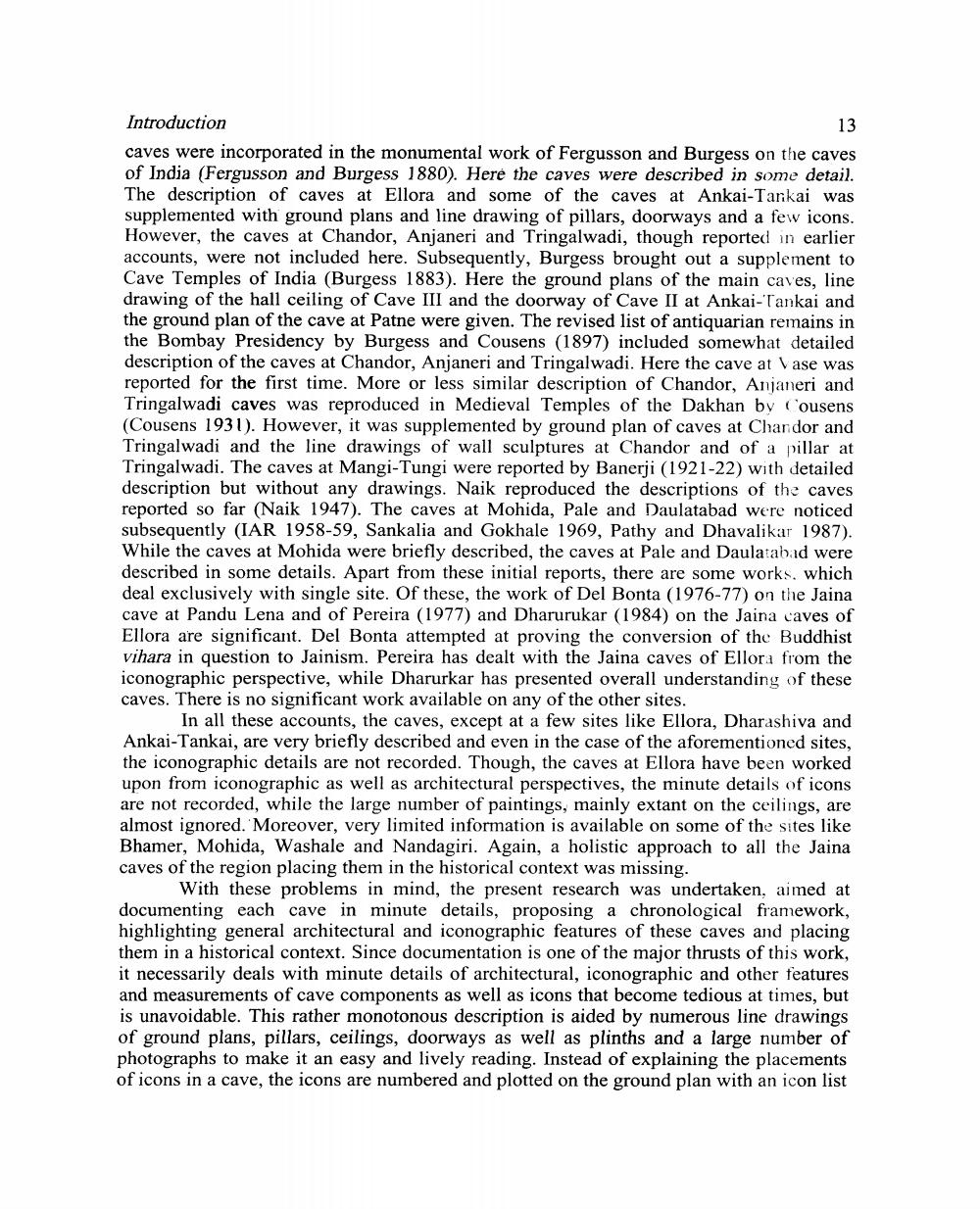________________
Introduction
13 caves were incorporated in the monumental work of Fergusson and Burgess on the caves of India (Fergusson and Burgess 1880). Here the caves were described in some detail. The description of caves at Ellora and some of the caves at Ankai-Tarkai was supplemented with ground plans and line drawing of pillars, doorways and a few icons. However, the caves at Chandor, Anjaneri and Tringalwadi, though reported in earlier accounts, were not included here. Subsequently, Burgess brought out a supplement to Cave Temples of India (Burgess 1883). Here the ground plans of the main caves, line drawing of the hall ceiling of Cave III and the doorway of Cave II at Ankai-Tankai and the ground plan of the cave at Patne were given. The revised list of antiquarian remains in the Bombay Presidency by Burgess and Cousens (1897) included somewhat detailed description of the caves at Chandor, Anjaneri and Tringalwadi. Here the cave at Vase was reported for the first time. More or less similar description of Chandor, Anjaneri and Tringalwadi caves was reproduced in Medieval Temples of the Dakhan by (ousens (Cousens 1931). However, it was supplemented by ground plan of caves at Chandor and Tringalwadi and the line drawings of wall sculptures at Chandor and of a pillar at Tringalwadi. The caves at Mangi-Tungi were reported by Banerji (1921-22) with detailed description but without any drawings. Naik reproduced the descriptions of the caves reported so far (Naik 1947). The caves at Mohida, Pale and Daulatabad were noticed subsequently (IAR 1958-59, Sankalia and Gokhale 1969, Pathy and Dhavalikar 1987). While the caves at Mohida were briefly described, the caves at Pale and Daulatabad were described in some details. Apart from these initial reports, there are some works, which deal exclusively with single site. Of these, the work of Del Bonta (1976-77) on the Jaina cave at Pandu Lena and of Pereira (1977) and Dharurukar (1984) on the Jaina caves of Ellora are significant. Del Bonta attempted at proving the conversion of the Buddhist vihara in question to Jainism. Pereira has dealt with the Jaina caves of Ellora from the iconographic perspective, while Dharurkar has presented overall understanding of these caves. There is no significant work available on any of the other sites.
In all these accounts, the caves, except at a few sites like Ellora, Dharashiva and Ankai-Tankai, are very briefly described and even in the case of the aforementioned sites, the iconographic details are not recorded. Though, the caves at Ellora have been worked upon from iconographic as well as architectural perspectives, the minute details of icons are not recorded, while the large number of paintings, mainly extant on the ceilings, are almost ignored. Moreover, very limited information is available on some of the sites like Bhamer, Mohida, Washale and Nandagiri. Again, a holistic approach to all the Jaina caves of the region placing them in the historical context was missing.
With these problems in mind, the present research was undertaken, aimed at documenting each cave in minute details, proposing a chronological framework, highlighting general architectural and iconographic features of these caves and placing them in a historical context. Since documentation is one of the major thrusts of this work, it necessarily deals with minute details of architectural, iconographic and other features and measurements of cave components as well as icons that become tedious at times, but is unavoidable. This rather monotonous description is aided by numerous line drawings of ground plans, pillars, ceilings, doorways as well as plinths and a large number of photographs to make it an easy and lively reading. Instead of explaining the placements of icons in a cave, the icons are numbered and plotted on the ground plan with an icon list




